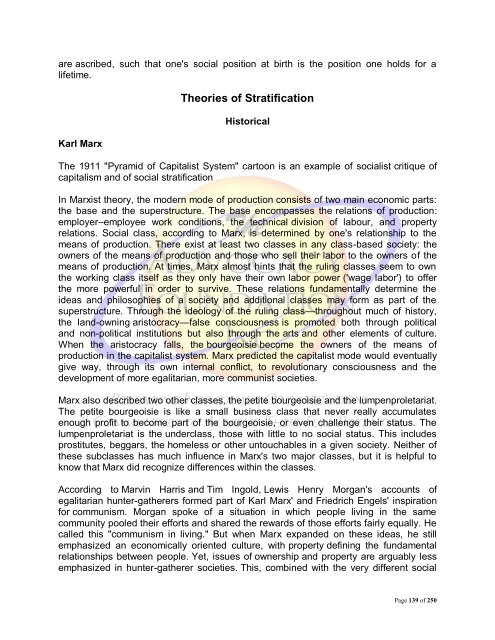Institutional Racism
Institutional Racism
Institutional Racism
Create successful ePaper yourself
Turn your PDF publications into a flip-book with our unique Google optimized e-Paper software.
are ascribed, such that one's social position at birth is the position one holds for a<br />
lifetime.<br />
Karl Marx<br />
Theories of Stratification<br />
Historical<br />
The 1911 "Pyramid of Capitalist System" cartoon is an example of socialist critique of<br />
capitalism and of social stratification<br />
In Marxist theory, the modern mode of production consists of two main economic parts:<br />
the base and the superstructure. The base encompasses the relations of production:<br />
employer–employee work conditions, the technical division of labour, and property<br />
relations. Social class, according to Marx, is determined by one's relationship to the<br />
means of production. There exist at least two classes in any class-based society: the<br />
owners of the means of production and those who sell their labor to the owners of the<br />
means of production. At times, Marx almost hints that the ruling classes seem to own<br />
the working class itself as they only have their own labor power ('wage labor') to offer<br />
the more powerful in order to survive. These relations fundamentally determine the<br />
ideas and philosophies of a society and additional classes may form as part of the<br />
superstructure. Through the ideology of the ruling class—throughout much of history,<br />
the land-owning aristocracy—false consciousness is promoted both through political<br />
and non-political institutions but also through the arts and other elements of culture.<br />
When the aristocracy falls, the bourgeoisie become the owners of the means of<br />
production in the capitalist system. Marx predicted the capitalist mode would eventually<br />
give way, through its own internal conflict, to revolutionary consciousness and the<br />
development of more egalitarian, more communist societies.<br />
Marx also described two other classes, the petite bourgeoisie and the lumpenproletariat.<br />
The petite bourgeoisie is like a small business class that never really accumulates<br />
enough profit to become part of the bourgeoisie, or even challenge their status. The<br />
lumpenproletariat is the underclass, those with little to no social status. This includes<br />
prostitutes, beggars, the homeless or other untouchables in a given society. Neither of<br />
these subclasses has much influence in Marx's two major classes, but it is helpful to<br />
know that Marx did recognize differences within the classes.<br />
According to Marvin Harris and Tim Ingold, Lewis Henry Morgan's accounts of<br />
egalitarian hunter-gatherers formed part of Karl Marx' and Friedrich Engels' inspiration<br />
for communism. Morgan spoke of a situation in which people living in the same<br />
community pooled their efforts and shared the rewards of those efforts fairly equally. He<br />
called this "communism in living." But when Marx expanded on these ideas, he still<br />
emphasized an economically oriented culture, with property defining the fundamental<br />
relationships between people. Yet, issues of ownership and property are arguably less<br />
emphasized in hunter-gatherer societies. This, combined with the very different social<br />
Page 139 of 250

















